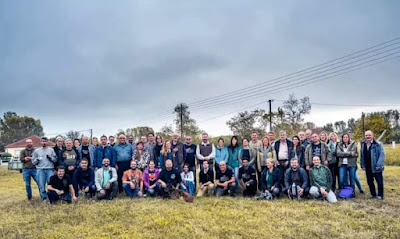The Golden Jackal repertoire
by Ovidiu C. Banea
Golden Jackal talks, vocalizations, and even the "letters of the songs" the species plays during the night are now closer to being known by humans.
Eurasian Golden Jackal
Canis aureus moreoticus (Geoffroy, 1835)
Photo: Ovidiu C. Banea, January 2023
Briefly, the sound is a vibration that propagates as an acoustic wave through a transmission medium such as a gas, liquid, or solid. Acoustic waves that have frequencies lying between about 20 Hz and 20 kHz, the audio frequency range, elicit an auditory percept in humans. Sound waves above 20 kHz are known as ultrasound and are not audible to humans. Sound waves below 20 Hz are known as infrasound. Different animal species have varying hearing ranges.
Herz is the measure of frequency and 1Hz means 1 cycle/second (time unit).
During the Kerkini Jackal Week meeting, Biologist Uthpala Jayaweera and Professor in Zoology Sampath Seneviratne from the University of Colombo showed the participants sonograms of the Sri Lankan Golden Jackal subspecies - Canis aureus naria (Wroughton, 1916) recorded howls and suggested that the "alphabet" has 23 syllables forming 5 vocalization types.
Sri Lankan Golden Jackal
Canis aureus naria (Wroughton, 1916)
Photo: Charles J. Sharp, February 2022
But one of the most interesting aspects is that some of the Golden Jackal emitted sounds are perceived by us with a range between 500 and 2500 Hz. Even more, there are patterns of "singing jackals" that can be reproduced by humans.
by Biologist Uthpala Jataweera
Janka Durova (Slovakia), Sampath Seneviratne (Sri Lanka),
Uthpala Jataweera (Sri Lanka), and Ovidiu C. Banea (Romania)
at Kerkini village, Greece (28.10.2023)
After a brief introduction to the spectral analysis of golden jackals sustained by Prof Seneviratne
Professor in zoology Sampath Seneviratne
Sonograms of the golden jackals were studied in Europe by Laszlo Szabo from Hungary (2009-2011), and by sound Engineer Carlo Comazzi (2015) in Italy.
Source: Carlo Comazzi, Silvana Mattiello, Olivier Friard, Stefano Filacorda & Marco Gamba (2016): Acoustic monitoring of golden jackals in Europe: setting the frame for future analyses, Bioacoustics, DOI: 10.1080/09524622.2016.1152564
In Romania, the
first sonograms were analyzed by Carlo Comazzi using recordings from "Danubius Jackal Camp" 2017, a wildlife survey organized in the Danube Delta Biosphere Reserve.
Spectral analysis of wild canid chorus was also used in wolves and the technique was suggested as an important tool complementary to other methods during the monitoring of the species. "Compared with other monitoring techniques (i.e., genetic analysis), bioacoustic analysis requires widely available informatics tools (i.e., sound recording set of devices and sound analysis software) and a low budget. Information obtained by means of chorus analysis can also be combined with that provided by other techniques. Moreover, howls can be recorded and stored in an audio file format with a good resolution (i.e. in “Wave” format), thus representing a useful tool for future listening and investigations, which can be countlessly employed without risks of time deterioration." Passilongo et al, 2015.
Wolves chorus spectral analysis (sonograms), Passilongo et al, 2015.
Spectral analyses of golden jackal howlings: 24th of October - 4th of November 2023
Wilde canids "singing" at Kerkini Lake
Red fox and Golden Jackal yip-howl ending of a specific howl followed by new linear vocalization
One or two golden jackal individuals chorus
Recording of a Golden Jackal territorial group. The low-frequency trace indicated a bigger size specimen. In the area wolves are present.
Two human voices imitating a jackal chorus
Comparative analysis between Golden Jackal howlings and human voices imitating the jackals
Hunting and spectral analysis of Golden Jackal chorus
The spectral analysis of wild canids shows different patterns if golden jackals are aggressively hunted with shot individuals almost every day, how occurred in the past at a waste dump in Trpanj (Croatia), where jackals replied from different angles at the same time during 2 minutes, with ununiform howlings and disorganized pattern. When there is NO Hunting or poaching, the Golden Jackal communicating behavior and territorial responses are organized with a consequent reply from every group with a total average of 27-35 seconds duration / each jackal chorus,







_male_and_pregnant_female_3.jpg)










%202010%20SONOGRAMA.png)
%202023-10-29%20a%20las%2023.06.17_192306.png)


%20-%20Golden%20Jackal%20and%20Cormorants.png)

%202023-10-29%20a%20las%2023.06.17_192306.png)

%20Detail%20SONOGRAM.png)
%20SONOGRAM.png)





















